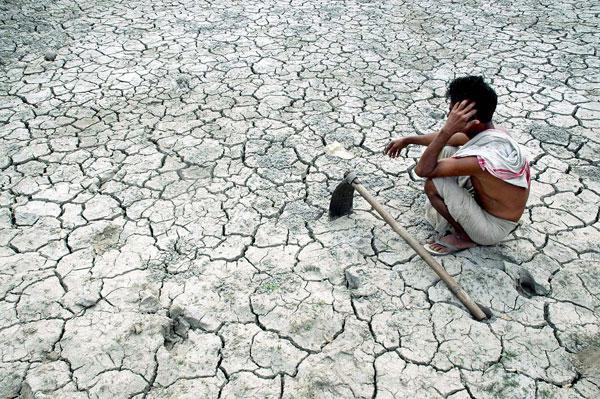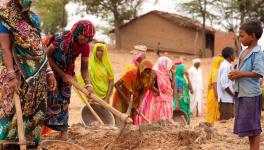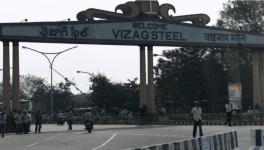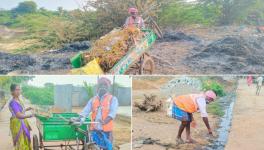Alarming Rural Distress

THE incidence of rural distress is assuming alarming proportions in many parts of the country. In those areas which are either perennially prone to drought or have suffered drought-like conditions in the last two years, the situation is nothing short of deadly. Even a short visit to such an area is enough to expose the hollowness of the assurances being given by the state and central governments and also their complicity in destroying lives and livelihoods here.
Anantapur district in Andhra Pradesh which receives very scanty rainfall and has a very high incidence of out-migration was selected by the then prime minister, Manmohan Singh, for the inauguration of the National Rural Employment Guarantee Scheme (later re-christened the Mahatman Gandhi Rural Employment Guarantee Scheme or MNREGS) in 2007. On February 3 of that year, accompanied by Sonia Gandhi, chairperson of the UPA, he arrived in Anantapur to announce that the government hoped that the provision of work and wages augmented by the infrastructure that would be created by the labour of the poor would alleviate poverty and check out-migration. The prime minister expressed the pious hope that the implementation of the scheme would bring smiles to the faces of those in distress.
We visited Anantapur on April 13-14 to find out for ourselves whether this goal has been achieved. What we heard and saw was even worse than what we had feared.
On the 13th, a big dharna of MNREGS workers and other poor people was held in front of the Anantapur Collectorate, demanding work and payment of arrears which total more than Rs 32 crores in the district. The denial of both work and payment is compounded by the fact that the wages actually paid are far below the statutory minimum. While there are more than seven lakh job cards in the district, until the day of the dharna, only two lakh people had been given work. Applications for work were pending in most of the talukas of the district and, with the onset of lack of work and non-payment of wages, migration had started.
Lakshmi Devi of Suryapalli village, a participant in the dharna, told us that she had been an MNREGS worker for three years. She had been working for the last 10 weeks at a work-site which was a two-and-a-half hour walk from her village which meant that she could only work for three hours a day. The mercury was already soaring. On that day it touched 44 degrees Celsius. She said that her wages for the entire period had not been paid.
When we met the assistant collector, he assured us that all arrears in the district would be cleared by April 25 and that he would personally see to it that all applications for work that were brought to him would be accepted within 48 hours. The leaders of CITU and the KVPS (Struggle Committee against Caste Discrimination) announced later at the dharna site that they would be collecting applications from villagers throughout the district.
The next day, we went to Guntakkal taluk of the same district. We visited three work-sites at Ayyavaripatta village. There were between 10-15 people at each site. Half of them were women. All of them were digging pits for water storage during the rains. While the digging was done by the men, the stony soil was put into baskets and then lifted on the head to be thrown away about five metres from the pit by the women. I lifted one basket and it was not less than 30 kilograms in weight. Each woman carried and emptied more than 70 such baskets in the course of her six hour work day which started at 6.00 am and ended at noon. They had to walk for about half an hour from their village to reach the site. It can only be imagined as to when they woke up to perform their many, arduous household chores. At the first site, we were told that they had been working for five weeks so far and had received NO payment at all. Even for work done in the previous year, one week’s wages were still pending. They said that the women received Rs 120 a day and the men, Rs 130. When the scheme was started in 2007, the wages were Rs 100 a day and today, eight long years later, they have gone up by Rs 20 and 30. Despite this, they were prepared to work for another five weeks and hope that they would be paid before the year ended. When we told them that the minimum wages in AP had recently been raised to Rs 258 a day, they are astonished.
At the second site, the workers said that they had been working for five weeks and had also worked for six weeks previous to this. ALL their wages were due. The women did not even know what wages they would get and thought that they would be between Rs 80 and 90 a day. The men said that they had worked for 150 days in the previous year and been paid between Rs 100-120 a day. This money had been deposited in the post office. Now they were told that the money would be deposited in the bank but they did not know which bank or which branch. They had wasted a lot of time trying to find out but had been unsuccessful. Even the Mate? at the site did not know which bank was being used.
Workers at the third site said they had been working for 45 days. While five of them had been paid, 10 had not. Those who had been paid had received Rs 150 a day each.
After this we visited Malleripalli village which has about 150 families most of them belonging to SC and OBC communities. Here we met Lalappa, an ex-sarpanch who is an MNREGS worker. He said that he had worked for three weeks four months back but his payment was pending. According to him another 100 people were in the same boat. Some 20-30 people had been paid Rs 150 a day. Lalappa said that he himself owned two acres of land but, because of the drought, not only small farmers like himself but even those owning 10 acres of land were turning to MNREGS work. He then told us that he had borrowed money from a money-lender at 24 percent interest (the usual rate) to sink three borewells. All of them had failed. He had sold the engines to pay back some of the interest but the principal remained unpaid and unchanged. In a district where farmers’ suicides are common, Lalappa is completely helpless. He cannot undertake agricultural operations and he is being denied the meagre wages due to him for back-breaking labour that he has performed.
A young girl, Priyanka, who lives with her grandmother is the victim of such tragic circumstances. Her father, Hanumanapppa committed suicide three years ago after also taking a similar loan to sink three borewells that all failed. No compensation was paid by the government. Her mother had died much earlier. Her brothers have left the village. She has just completed her 10th standard and wants very much to study further but knows only too well that this will not be possible. We fell silent, sharing her pain. Just then, SFI comrades who were with us assured her that they would get her admission in the hostel and college in Anantapur where she would also get the benefit of an SC freeship. CITU and CPI(M) leaders added that they would be responsible for any expenses that her further education would entail. Priyanka was greatly relieved but was also anxious that her hopes would not be dashed as they had been in the past.
Lack of work and wages have already forced 50 people to migrate from the village. They join others who pick chillies in Guntur, work on construction sites in Bengaluru and Mumbai and become rag-pickers in Mumbai. Many never return. Mastaan Amma’s son left two years ago and she has not seen him since. He sent Rs 2000 to her once. Now she has lost all hopes of seeing him again and, bereft of hope, she embodies the anguish of rural distress.
As we were leaving the village, we saw the strange site of newly constructed toilets, 30 of them. The state and central governments had promised that all those constructing such toilets would be given Rs 15,000 each. They had been constructed at a cost of Rs 20,000 but the government money had not come. We asked the villagers if the toilets were functioning and they laughed: when there was no water to drink, where would the water for the toilets come from?
Finance Minister Jaitley announced that this year’s budget was increasing allocation for MNREGA by 1,000 crores over the last year.
55 percent of total payments however are delayed and pending liability in this fiscal year is estimated at Rs 6,500 crores.
Therefore, the increased allocation is not nearly enough to clear the arrears, increase the number of work days (the national average is still far from reaching 100 days) and bring wages to the level of state minimum wages.
Get the latest reports & analysis with people's perspective on Protests, movements & deep analytical videos, discussions of the current affairs in your Telegram app. Subscribe to NewsClick's Telegram channel & get Real-Time updates on stories, as they get published on our website.
























